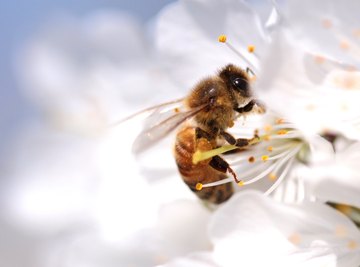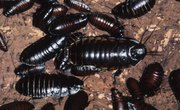
The bright yellow and black stripes on many bees and wasps successfully fend off many potential predators, warning those other animals of the dangerous stingers these insects possess. Some predators, however, have thick enough skin to withstand a few stings, quick enough speed to avoid stings altogether or deadly enough poison to stand up against the threat presented by wasps and bees.
Birds
At least 24 species of birds reportedly eat wasps and bees. The most obvious come from the "bee-eater" bird family, which mostly lives in tropical and subtropical regions of Eurasia, Africa and Australasia. North America's northern mockingbird eats a variety of insects in the summer, including bees and wasps, as does the summer tanager, located in southern North America, Central America and South America. The ruby-throated hummingbird will also grab smaller bees flying around nectar. Other bee and wasp eating birds include the blackbird, magpie and starling.
Mammals
A variety of omnivorous mammals, from small species to larger animals, also prey on wasps and bees. In Great Britain, badgers act as the primary predator of wasps and often destroy colonies for the comb containing young wasps and eggs. In North America, the black bear eats bees and wasps. In addition to intentionally eating these stinging insects, black bears also enjoy eating the honey found in beehives. Early wasp colonies can also fall victim to stoats, weasels and mice.
Reptiles and Amphibians
Several species of lizards chase and devour wasps. Geckos, especially, pursue wasps and even go so far as to eat through relatively unguarded wasp nests to eat the larvae inside. Asian geckos even eat Polistes, a genus of wasp measuring around 15 millimeters in length who possess a harsh sting. Some amphibians, including types of frogs, toads and salamanders -- such as the Indiana northern dusky salamander -- also prey on wasps or bees and their larvae.
Insects
A large portion of wasp and bee predators fall into the insect or invertebrate category. Predators from this category include dragonflies, robber flies, hornets, centipedes and spiders. Robber flies can grow to two centimeters or more in length and have proboscis capable of injecting wasps and other insects with a paralyzing neurotoxin. Various garden spiders also eat wasps and bees caught in their webs. Even the praying mantis will strike down any unfortunate wasp that flies in its path.
References
About the Author
Caitlynn Lowe has been writing since 2006 and has been a contributing writer for Huntington University's "Mnemosyne" and "Huntingtonian." Her writing has also been in "Ictus" and "Struggle Creek: A Novel Story." Lowe earned her Bachelor of Arts degree in English from Huntington University.
